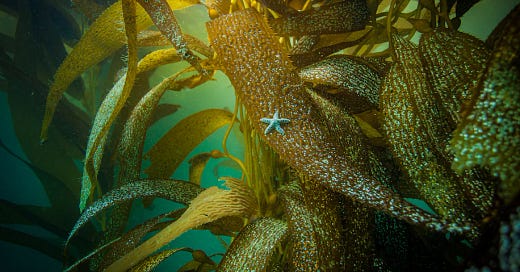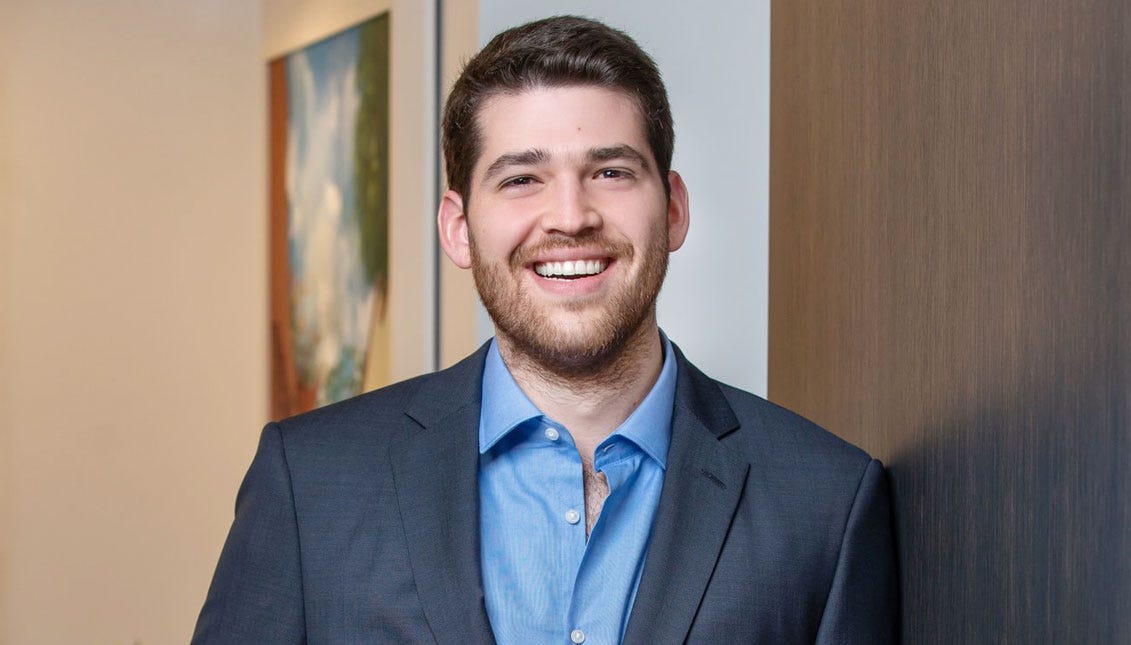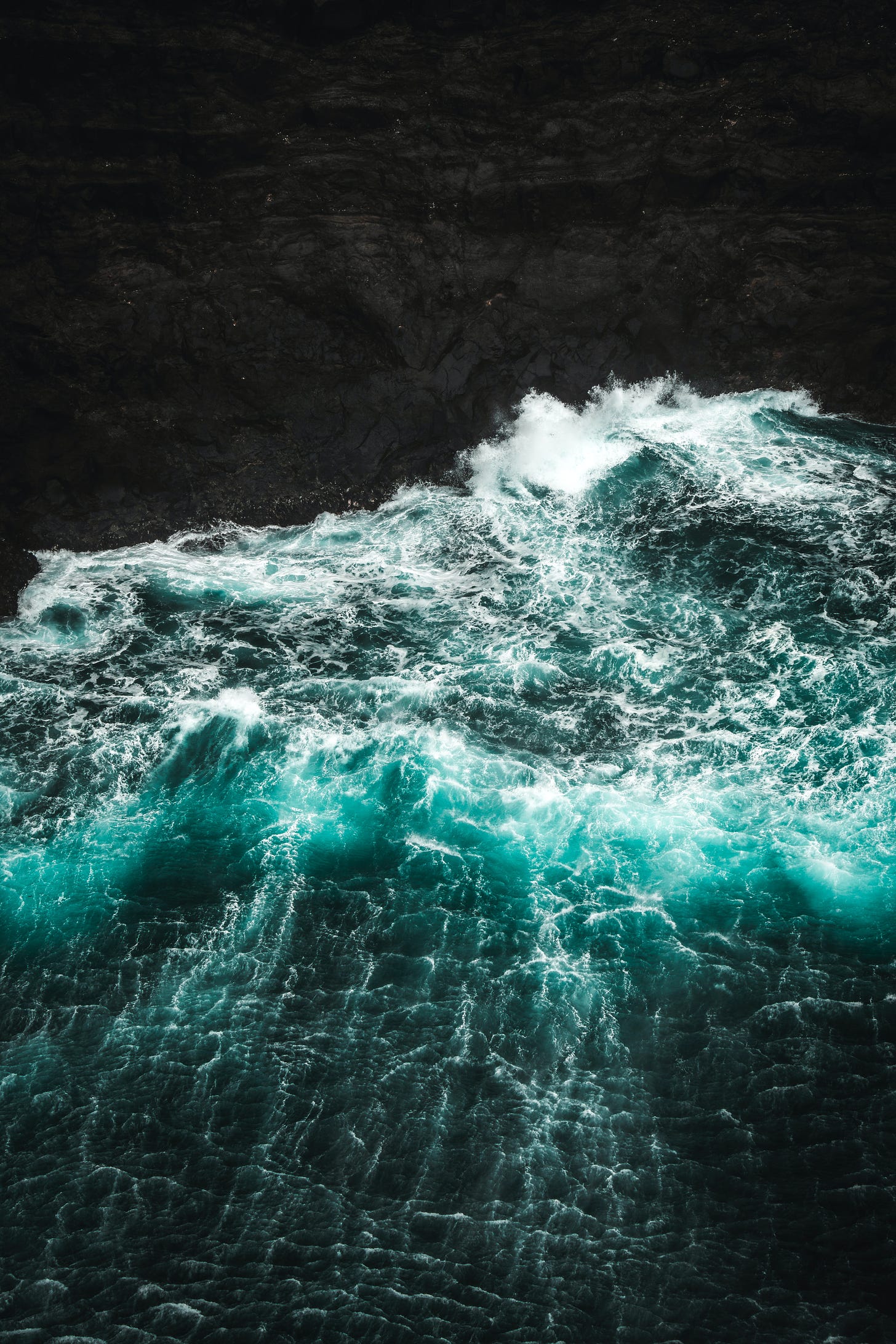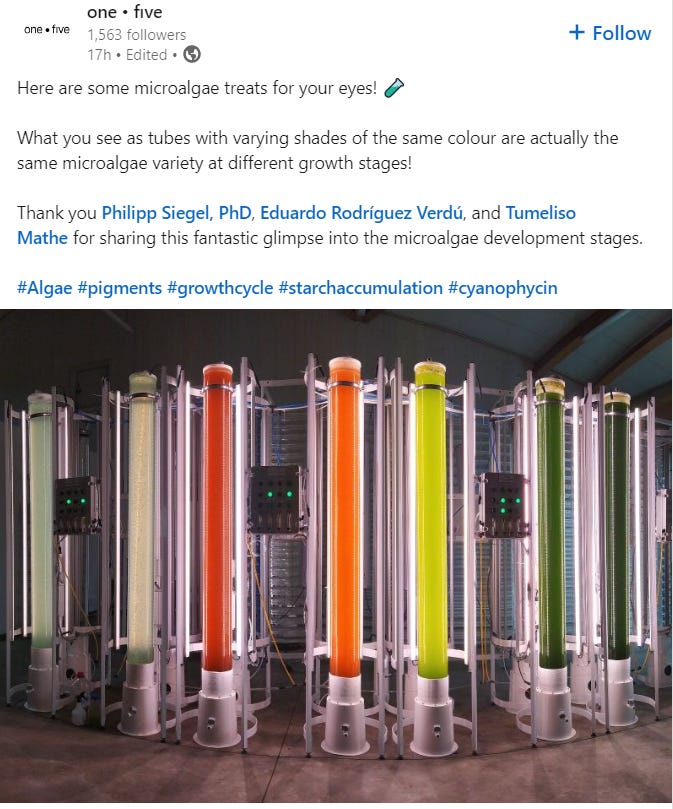🚨SOS Carbon?
PLUS The new climate bill, Sea6 Energy raises $18.5 million and Tutankhamun perfume oil.
"Bring stakeholders together and learn from as many people as possible. By teaming up with folks with different skillsets, you can really start to move the needle." — Andrés Bisonó León, SOS Carbon
Dear algae technologists - hello and welcome to the Paxtier Report!
This week, Ralph Pace showcased some magical conservation success stories.
His “comeback kid” series features sea turtles, sharks, and harbor seals - but for me, nothing beats the kelp forest snaps:
See more HERE.
In today’s report:
Markets: 🌊The new climate bill’s ripple effect on oceans
Deals: 🤝Ocean farming startup Sea6 Energy raises $18.5 million
Research Rundown: 🧪New phytoplankton model questions climate predictions
Movers and Shakers: 🚨SOS Carbon?
Around the web: 💡100 ideas that can change 1 billion lives.
Markets and Investing
✂️Algae Market Snippets
Some recent big moves:
Canadian Cooke acquires Tassal for $1.1 billion. Cooke will acquire 100 per cent of Tassal for $5.23 per share. According to reports, Tassal has become Australia’s largest seaweed farmer, having grown around 3300 tonnes of seaweed and removed 22 tonnes of nitrogen from prawn ponds. (Read more HERE).
Iberdrola aims to design offshore wind farms that protect the environment - and there’s a call for sustainable materials and algae (Read more HERE).
MiAlgae secures £2.3m investment for high-value microalgal products - (Read more HERE).
AgriSea is awarded $2.7 million for the Rere ki Tai project (HERE) and $750,000 for its seaweed-based nanocellulose partnership.
$500,000 goes to study investigating mitigation options for sargassum in the U.S. Virgin Islands (Read more HERE).
Aliga Microalgae has purchased Duplaco B.V’s production facility in Holland. (Read more HERE).
Sea6 Energy has raised $18.5 million in Series B funding. (Read more HERE).
Ocean 14 Capital Fund is over halfway to raising €150 million (Read more HERE)
Carbonwave targets Asia’s clean beauty market with upcycled seaweed emulsifier (Read more HERE).
Simris Alg to acquire Cyano Biotech GmbH as it targets biopharma (Read more HERE).
Fijian women harvesting seaweed struggle as yields plummet amid climate change. (Read more HERE)
Scarborough's seaweed farming company, SeaGrown, has won a £2.8million Government contract that aims to scale renewable energy. (Read more HERE).
Norway's ministry of trade is submitting a proposal to define all kelp and seaweed as seafood so that it can be marketed abroad by the NSC. (Read more HERE).
The new climate bill’s ripple effect on oceans - featuring $2.6 billion in grants to states and tribal governments to help restore kelp beds, mangrove forests, salt marshes and sea grasses (Read more HERE).
In depth with Peter Green
🚨SOS Carbon?🚨
In 2018, Andrés Bisonó León co-founded SOS Carbon, an MIT startup minimising sargassum’s economic and environmental impact on the Caribbean.
Over the past few years, this company has developed two key pieces of tech - a cost-effective, low-impact Littoral Collection Module (LCM) for sargassum harvesting, and a patent-pending pumping device to send sargassum to the deep ocean.
Thanks to these innovations - which you can check out in this paper (and video below) - SOS Carbon has showcased how to rally major stakeholders around an important environmental cause...
... But what can we learn from their experience? And what advice can they offer to other algae entrepreneurs?
To learn more, I scheduled a quick call with Andrés. And in this teaser from our recent chat, we discuss the motivation for creating SOS Carbon, his thoughts on sinking sargassum, and advice for others in the space.
When did SOS Carbon get started?
Things really kicked off in 2018, when I teamed up with my good friend and mentor Dr. Alexander Slocum at MIT.
Dr. Slocum is an expert in creating multifaceted solutions and designing machines for global good. We wanted to combine this experience with our shared passion for climate and that’s what led to the creation of SOS Carbon.
At SOS Carbon, we have two main objectives - relieve the Caribbean of its enormous sargassum burden and make a positive impact on climate change.
What’s the current consensus on sinking seaweed?
From our point of view, the momentum is shifting towards sinking. That’s because it’s the most viable way to deal with invasions, sequester carbon and avoid massive land transportation emissions.
Clearly, more environmental assessments are needed to validate this form of carbon sequestration. And we are fully behind those investigations. But we decided to be proactive and set about building the necessary technology in advance.
Despite this, if more beneficial approaches are developed in the future, we will happily shift our focus.
How did you get Caribbean stakeholders involved in your project?
Getting stakeholders in Latin America involved required a lot of time, work and resources.
But we were set on getting buy-in from those major players. So, we approached several socially and environmentally responsible organisations who understood the importance of joining forces.
And this sparked interest from other groups in the public, private and academic sectors - eventually helping us become a nexus for stakeholders in the field.
What advice would you give to others in this domain?
Tourism, small businesses and governments are suffering tremendously from this invasion. As a result, it’s important to act with urgency, invest in cost-effective infrastructure today, and scale a platform to transform sargassum into various valuable products.
In addition, it's so important to bring stakeholders together and learn from as many people as possible. By teaming up with folks with different skillsets, you can really start to move the needle.
If you’d like to learn more about SOS Carbon, I’d highly recommend that you check out their paper, this interview with Phyconomy, and follow Andrés on LinkedIn .
📝Research Rundown: New phytoplankton model questions climate predictions
THE BIG IDEA
For years, biogeochemical models considered phytoplankton as passive drifters - non-active organisms which simply go with the ocean’s flow.
But Wirtz et al. had a problem with this approach. There was simply too much data stating that phytoplankton could migrate vertically through the water column. And this behaviour was too important to ignore.
To address this, on August 2nd, 2022, the team released a new model - one which factors in highly motile autotrophs.
And the results could massively impact future climate predictions.
The breakdown
Essentially, the paper explains how phytoplankton can vertically migrate up to 80 metres - using energy from photosynthesis to sink, and nutrients from the deep to resurface:
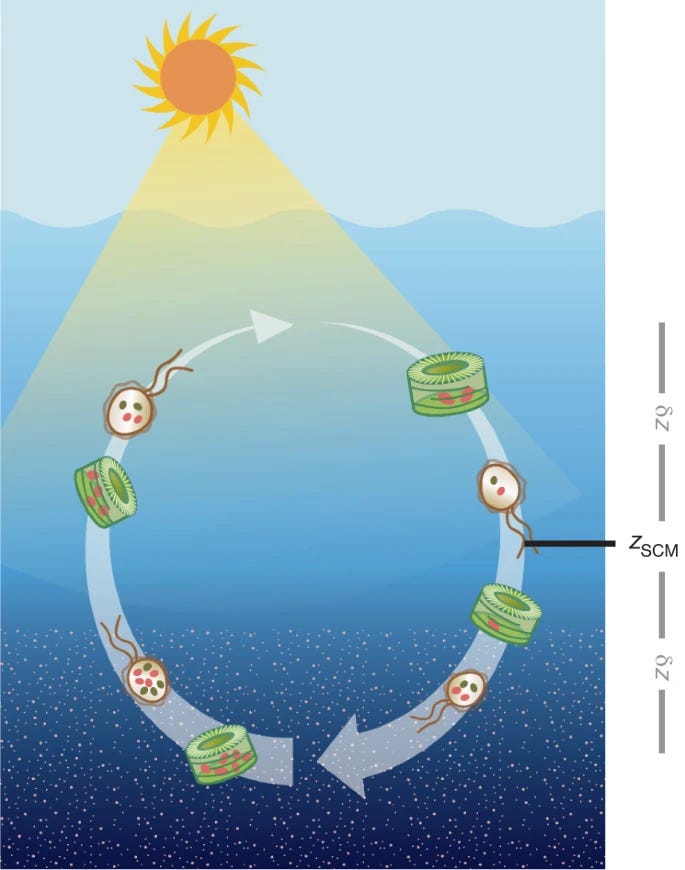
This process creates a highly efficient carbon pump - something which hasn’t been factored into conventional carbon models - meaning that “previous calculations may have underestimated marine productivity and carbon uptake significantly.”
And if these results prove to be true - up to 40 gigatons more CO2 per year would be absorbed by the oceans than current climate models predict.
Making Y Combinator and Stripe’s call for phytoplankton start-ups all the more interesting.
🔥 What else was hot in algae tech this week?
(Paper) High impact of bacterial predation on cyanobacteria in soil biocrusts (Nature)
Ulva. Too much - or not enough? (Read more HERE).
Can Microalgae Oil Replace Unsustainable Palm Oil? (Read more HERE).
100 Ideas That Can Change 1 Billion Lives. Check out this awesome list featuring algae teams like Arborea, Volta GreenTech, and Running Tide. - (Read more HERE)
Festo demonstrates an automated bioreactor for large-scale photosynthesis of algae (Read more HERE).
Biochar may help fight against harmful algal blooms (Read more HERE).
Ocean on Land Technology’s Algae In-a-Box is a modular, moveable system that works in varied environments, allowing simultaneous growth of multiple algal species (Read more HERE).
Petition to clean up Windermere passes one hundred thousand signatures(Read more HERE).
Algae: The trending skincare ingredient against hyperpigmentation (Read more HERE).
The plans for giant seaweed farms in European waters. (Read more HERE).
KAUST produces Tutankhamun perfume oil from algae (Read more HERE).
Macroalgae from the coast of Peniche can delay skin aging (Read more HERE).
After the I2U2 summit, could the blue economy assist Asia's rise? (Read more HERE).
Returning sea otters to Oregon could revive kelp forests (Read more HERE).
NOAA’s New Strategic Plan for Seaweed Aquaculture (Read more HERE).
🐦Tweet of the week
Jobs
Chemical Process Engineer - Macro Oceans - Sacramento, CA
That’s all folks!
Thanks again for joining us this week. Hope you have a great day and stay tuned for more algae tech updates soon!
Peter

